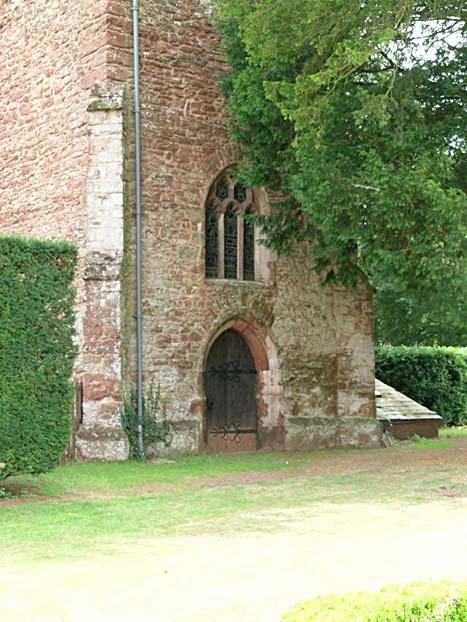FOUNDATION AND EARLY CHURCH AT NYNEHEAD
All Saints Church, Nynehead is one of the gems of Somerset. The main fabric of the building consists mostly of local red Permo-Triassic rock, a form of sandstone, mixed with various other types of stone. The style is perpendicular. The building owes a great deal to the Sanford family who in the past furnished it with many of its present day art treasures.
In the building of churches many pieces of the older buildings were reused. In the early 19th century a carved stone head was found while the restoration of the church was in progress. This may indicate that the present day church was built from the remains of a former building. Also older pieces of the original church appear in other places e.g. the piscina in the sanctuary.
The manor was granted to the Bishop of Winchester in 737 AD, so it is likely that there was some form of a church here at that time. A church in Nynehead is mentioned in the Domesday Book of 1068. By a charter dated 1091, William, Count of Mortain, founder of the Montacute Priory, granted to the monks of Montacute the manor and the church of Nynehead. It was the only Cluniac Order in the county, an order that was developed from Cluny in Burgundy.

The name Nynehead is unique as it is the only place with this name in the world. Documentary evidence of human settlement can be traced back to Saxon times, while the archeological record pushes the boundary much further back. The first date Nynehead was mentioned was in 737 A.D. when the Manor was granted to the Bishop of Winchester. In A.D. 890 land was granted to a Wulfhere Gidding, at a yearly rent of 20 shillings “on condition that the tenant shall be a follower of the Lord of the church.” The actual name Nynehead is derived from the area of the Parish at that time which was nine hides i.e. Nigonhidon (A.D. 897) which then gradually changed over the years e.g. Nichehede (1086); Neghenhude (1327); Nyenhide (1410; finally Nynehead in the 19th century. The name Nynehead is of Anglo-Saxon origin, in Thomas Gerard's book ‘Particular Description of the County of Somerset’ in 1633 he said of the name
“Whose very name shewes what quantity of grownd is comprized.”
A hide is a unit of land measurement thought to equal 120 modern acres so ‘9 hides’ equates to about 1000 acres. In 1091 the Manor and the church were granted to the Fleury family and the name then changed to Nynehead Florey which referred to the area around the church and Court and East Nynehead was Nynehead Monks.
The village church is situated towards the western end of the five hamlets of Nynehead and overlooks the old school building and the lower end of the village. It stands on fairly high ground and from the church tower, one has a panoramic view of the Blackdown Hills to the south and the Brendon and Quantock Hills to the north.
It is probable that there was a simple church on this site in A.D 890 because the condition of renting the manor was that the tenant should follow and worship the Lord. A church at Nynehead is mentioned in the Domesday Book of 1068. Then by a charter dated 1091, William, Count of Mortain, founder of the Montacute Priory, granted to the monks of Montacute the manor and church. The Montacute Priory was founded by William, Count of Mortain, in about 1100. It was the only Cluniac Order in the county, an order which was developed from Cluny in Burgundy.
In 1292 the rectorial tithe was worth six and a half marks. A mark was a bar of silver, weighing about half a pound. The tithe at this time went to the Taunton Priory, as one of the monks would have served as the parish priest.
The canons and monks had beards, their habit was a black cassock over which was a white rochet, with a black cloak and hood and a cap on the head. As is the case with most church buildings, various alterations and additions have been made over a period of time.
After the Reformation the tithe reverted to the Crown. In 1554 Queen Mary presented a vicar to the parish. Then Queen Elizabeth 1 presented three vicars in 1564, 1567 and 1570. James 1 presented one vicar in 1618. Charles 1st presented the vicar in 1638. Charles 2nd presented 2 vicars; William 3rd, George 1st , George 2nd and George 3rd all presented vicars to Nynehead. The last vicar to be presented by the Crown was Dr Thomas Bovet in 1786; after this the patronage came into the possession of the Sanford family until the late 20th century. The Sanford family lived in Nynehead Court between 1590 and 1919.
The value of the living in 1695 was £8 7s 11d but by 1788 this had risen to £70. In 1923 the Vicarial tithe was £225 per year plus residence and eleven and a half acres of glebe (land for the vicar to farm).
